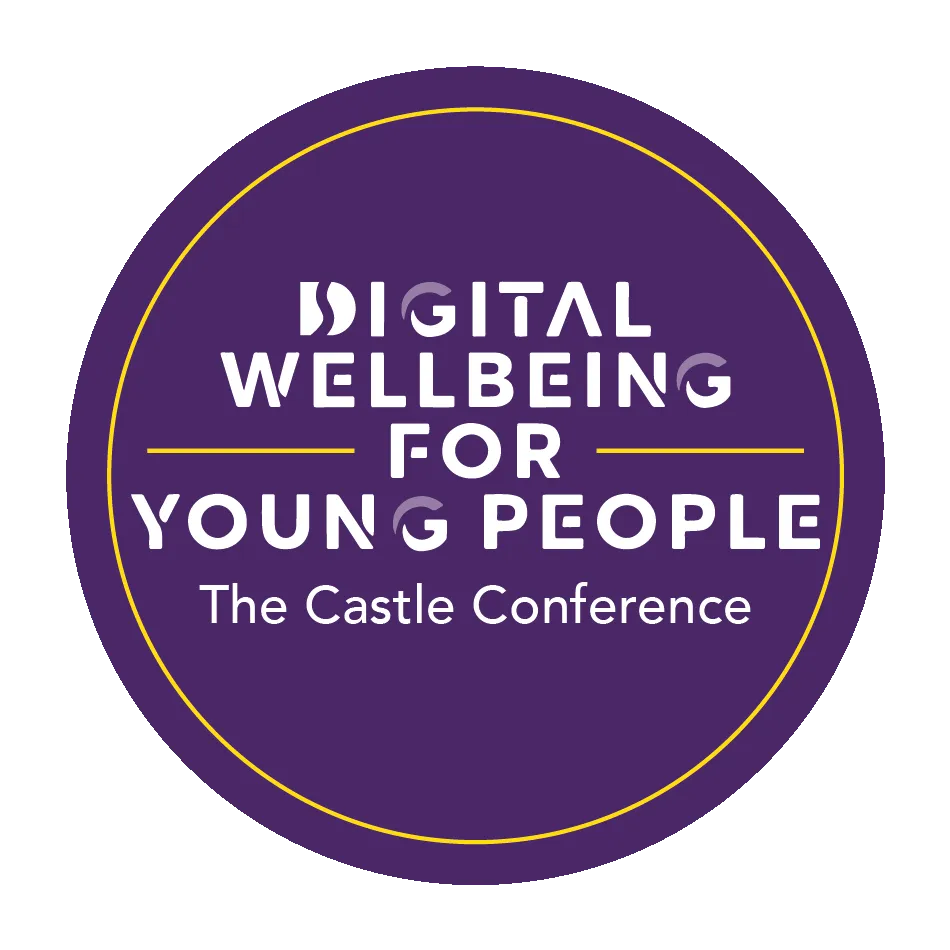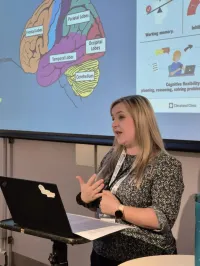Thank you for helping to
Keep the conversation going
Here are some ways we can help you.
We hope you enjoyed The Castle Conference: Digital Wellbeing for Young People.
We know you want to keep the conversation going so we have created a page to help you do that.
The page will be updated with slides and videos when they are available.
Watch the Castle Conference Catch Up
We hope that The Castle Conference inspired you, got you thinking and talking about the topic of Digital Wellbeing. We really hope you have been talking about the conference to your friends, family and colleagues.
We certainly are and we arranged it!
The Castle Conference Catch-Up was a chance to keep talking, a chance to share your thoughts, a chance to find out what questions we have been asked since the day and a chance to ask us new questions.
Andy & Lucy
Recap from the event
We have combined the slides into a video for you to rewatch
This is only the slides - no audio. Videos are below.
Speaker Videos
Lucy Smith: Digital Safeguarding and Neurodiversity
Professor Peter Kawalek: A crisis but not of their making
Luisa Fassi: Social media and adolescence
David Brown: If U Care Share
Resources
Links and downloads for you

ADHD & Time Management: Pomodoro Technique
ADHD & Time Management Blog - Pomodoro Technique
Have you considered organising your workday into 16 ‘tomato’ intervals? The Pomodoro Technique might suit you if:
You often find yourself side-tracked by other responsibilities during work
You tend to overload your daily schedule
You routinely handle tasks with unpredictable time requirements
You frequently work beyond your peak productivity hours
This time management strategy is simple to adopt and has been utilized across various sectors for years. This guide will delve into the Pomodoro Technique, its application in project management, and explore some popular alternatives.
What is the Pomodoro Technique?
The Pomodoro Technique is a widely-used time management method for task completion. It involves alternating between focused work periods (Pomodoros) and scheduled breaks. Typically, work sessions last 25 minutes, followed by five-minute breaks.
In the late 1980s, Francesco Cirillo, a university student feeling overwhelmed by his coursework, decided to commit to just ten minutes of focused study. This experiment led to the development of the Pomodoro Technique, named after the tomato-shaped kitchen timer he used ("pomodoro" means tomato in Italian).
By dividing larger tasks into smaller, manageable chunks, the technique makes them less daunting. It also promotes periods of uninterrupted concentration and flow, interspersed with breaks that allow mental relaxation and help maintain work quality.
While Cirillo now offers comprehensive Pomodoro time management courses, the basic concept remains straightforward.
The Pomodoro Technique consists of six main steps:
1. Choose a task
Choose a task from your pre-planned pomodoro schedule. Planning your tasks in advance makes implementing the Pomodoro Technique much smoother (more on this later).
2. Start the timer
Set a timer, usually for 25 minutes. Cirillo suggests using a kitchen timer to avoid digital distractions. The physical action of winding the timer initiates your work session, its ticking keeps your mind on task, and the ring signals break time. However, a stopwatch or Pomodoro app can also suffice.
3. Focus on the task
Once the timer starts, concentrate solely on your chosen task until it rings. Minimize distractions and defer other tasks or messages until your break. If you finish early, use the remaining time to review your work, tackle a similar task, plan upcoming tasks, or study related material.
4. Take a short break
When the timer sounds, pause your work for a short break, typically 5-10 minutes. You may also use this time to briefly log your accomplishments.
5. Repeat the cycle
Repeat the work-break cycle three more times. You may continue with the same task or switch to a new one, based on your daily plan. If an unavoidable interruption occurs, take your break early and restart the pomodoro afterward. Note these disruptions to help prevent them in future sessions. After completing four pomodoros, move to step 6.
6. Enjoy a longer break
Having worked for about two hours and completed a "pomodoro set" (four pomodoros), take an extended break of 20-30 minutes to recharge. Once this break ends, return to step 2 (or step 1 if beginning a new task).
Here’s a visual example of how this would look in practice:

Why This is Great for Neurodivergent People
The Pomodoro Technique can be particularly beneficial for neurodivergent people as we may experience challenges around time perception, task initiation, and focus regulation.
We've dug a bit deeper into why its beneficial for us:
Using a physical timer, or one like this timer that changes colour as it ticks, removes the barrier of object permanence affecting our relationship with time passing us by. Externalising time with a physical timer means that we turn something abstract that we can't normally see into a concrete, tangible thing within our control.
The Pomodoro Technique, or time blocking, provides clear boundaries around work and rest, which can reduce overwhelm and anxiety around open-ended tasks or unstructured time for us
Time blocking reduces executive function load. For many of us, decision-making fatigue and mental effort can build up quickly. Breaking tasks into smaller, time-boxed sprints reduces the cognitive load of sustaining attention for long periods.
Built-in movement and sensory breaks: The scheduled short and long breaks help to prevent burnout, encourage regular movement, and create space for sensory regulation—whether that’s a quick walk, a stretch, or a calming activity that helps reset your nervous system.
Creates urgency without pressure: Many neurodivergent people benefit from external motivators or time-limited tasks, as these can help initiate action without feeling overly restrictive or anxiety-inducing.
Minimises hyperfocus burnout: While hyperfocus can sometimes feel productive, it often leads to exhaustion or skipping meals and self-care. The Pomodoro system helps balance deep focus with built-in pauses to check in with your body and energy levels.
Encourages self-awareness and pattern spotting: Tracking interruptions and noting how many pomodoros a task takes can help build useful insights into how your brain works best. Over time, you can tailor your schedule to match your natural energy patterns and capacity.
Our Tips for Adapting the Pomodoro to Work for YOUR Brain
The original Pomodoro Technique is a great starting point, but you don’t have to stick rigidly to 25/5 intervals! Try experimenting with different work and break lengths – perhaps 15/5, 40/10, or even 60/15 works better for you depending on your focus window. Our coaching team will work with clients to find their optimal focus window, and for some of us at Inclusive Change, our optimal focus window is 10 minute bursts!
You can also try using visual or sensory timers like hourglasses, visual countdowns, or tactile timers if auditory cues are distracting or overwhelming. We’ve included a link to a colour changing timer here: https://amzn.to/4bFvkxF
We've also found pairing Pomodoros with body-doubling incredibly effective. Body doubling is working alongside a colleague or virtually with someone for accountability and motivation, and this also increases both people's productivity. If you're someone who will hyperfocus, set an additional cue (like a vibrating watch or reminder) to encourage stepping away for breaks, and ask a colleague to come along and prompt you gently with a message or invitation to go for a walk.
Take regular short breaks to reset your nervous system, not just scroll your phone. Consider stretching, breathing exercises, or going outside for fresh air.
If you’re sensitive to pressure, you could treat the timer as a “focus container” rather than a strict deadline; something gently nudging you into flow without creating time anxiety. We like to combine Pomodoros with task batching by grouping similar tasks into one focus block to reduce context switching for our autistic clients.
Would you like to know more about our coaching services? Book in a call with us here for a chat about how we can help:

Get Your FREE eBook
A Practical guide to Simplify your Digital Life

Digital Safety CIC - Online Resources
Exhibitor Information
We think you will agree that our exhibitors contributed so much to the event.
We know that we can tackle the problems we face alone - which is why we love working with others.
Thank you - you made the day INCREDIBLE!

Inclusive Change At Work CiC
Bradbury House
Wheatfield Road
Bradley Stoke
Bristol
BS32 9DB
Companies House: 13271923
ICO registration: ZZB293922
UK register of Learning providers
UKRLP: 10090653
Privacy Policy | Terms and Conditions
Copyright © 2025 Inclusive Change At Work CiC | All Rights Reserved




